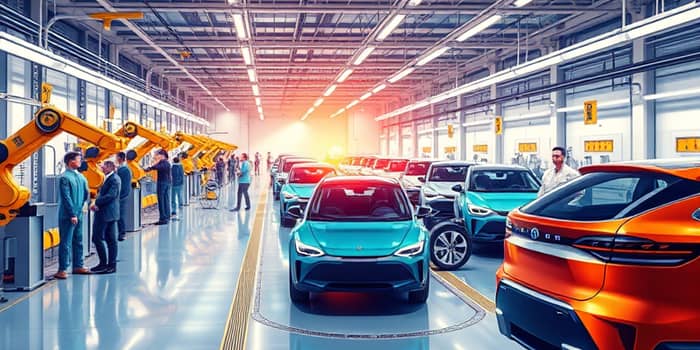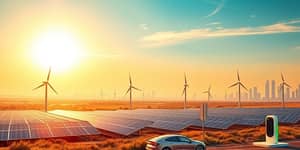
The global auto industry is undergoing a profound transformation as electric vehicles (EVs) surge in popularity, reshaping investment priorities and manufacturing strategies worldwide. Investment flows are reacting to shifting consumer preferences, stringent emissions targets, and the rapid pace of technological innovation. In this comprehensive analysis, we explore the latest data, drivers, challenges, and future projections that define this pivotal moment for the auto sector.
Electric vehicle sales have reached unprecedented levels, signaling a new era of automotive growth. Over 3 million electric cars were sold worldwide in Q1 2024, marking a year-on-year increase of about 25%. Industry forecasts estimate global EV sales will approach 17 million units in 2024, reflecting an annual growth rate exceeding 20%.
Regional trends showcase varying dynamics. In the U.S., nearly 300,000 new EVs were sold in Q1 2025, up 11.4% year-over-year, representing 7.5% of all new vehicles. China leads the global market, where electric models account for over half of new car sales. Europe follows closely, with strong incentives and infrastructure driving adoption.
Segment-specific trends reveal that new models from brands such as Acura, Audi, Chevrolet, Honda, and Porsche are boosting sales, while some legacy offerings see declines. Meanwhile, used EV markets are expanding, with Tesla commanding a 27% share of pre-owned electric car sales as of April 2025.
Automakers and investors have committed extraordinary capital to support the EV transition. Between 2022 and 2023, reported investment announcements reached $275 billion for EV production and $195 billion for battery manufacturing, with approximately $190 billion already committed across global projects. Industry forecasts suggest automaker capital expenditures on electrification could total $108 billion by 2030.
To meet growing demand for battery cells and components, at least $35 billion is needed for new plants by 2030—a threshold already surpassed by $155 billion in planned investments. National incentives and domestic content requirements boosting local manufacturing are further accelerating these projects.
More than 20 original equipment manufacturers (OEMs), collectively representing over 90% of global car sales, have set ambitious EV deployment targets. General Motors sold over 30,000 EVs in Q1 2025—almost double its year-ago figure—surpassing Ford and Hyundai. Honda and Acura achieved combined sales of over 14,000 EVs in the same period, up from zero the previous year.
Renewed investment in EVs is propelled by a combination of regulatory support, consumer demand, and technological advances. Governments worldwide are implementing stringent emissions regulations, offering purchase incentives, and establishing charging infrastructure. Tariffs and industrial policies continue to shape market entry strategies, with nearly half of U.S. consumers indicating that trade policies influence their EV buying decisions.
Consumer attitudes are shifting rapidly. Environmental awareness, total cost-of-ownership considerations, and fuel price volatility are driving interest in electrified mobility. According to Morgan Stanley, 29% of consumers are interested in purchasing an EV, while another 24% consider a hybrid. Projections indicate price parity between EVs and internal-combustion vehicles is within reach, supported by declining battery costs—entry-level EVs could drop to around $18,000 by 2025.
Despite robust growth, the EV market faces challenges. Some manufacturers report monthly sales declines as economic uncertainties and inventory cycles create volatility. Policy shifts in major regions, including changes to tax incentives and emission targets, can pressure short-term demand.
At the same time, electrification is expanding into diverse segments beyond passenger cars. Commercial vans, buses, heavy trucks, and two- and three-wheelers are joining the EV revolution, with projections indicating over 90% of sales in these categories will be electric by 2040. New entrants—from legacy brands launching dedicated EV lines to startups targeting niche markets—are intensifying competition and spurring innovation.
The trajectory for EV adoption remains strongly positive. By 2030, electric vehicles could represent 42–58% of global new car sales, rising to 73 million annual units by 2040. In North America, continued infrastructure expansion and consumer incentives will push market share higher from the current 7.5% level.
As battery technologies mature and charging networks densify, total cost-of-ownership advantages for EVs will strengthen, accelerating adoption curves globally.
The shift to electric mobility has significant environmental benefits. Widespread EV deployment is expected to reduce oil demand by millions of barrels per day, cutting greenhouse gas emissions and improving urban air quality. However, electrification alone will not achieve net-zero targets by 2050. Continued regulatory support, renewable energy integration, and sustainable battery supply chains are crucial.
Policy frameworks must evolve to address end-of-life battery recycling, raw material sourcing, and charging infrastructure equity. Collaboration between governments, automakers, and energy providers will determine the pace at which environmental goals are met.
As the auto sector enters this new investment cycle, stakeholders must navigate a complex landscape of technological change, regulatory evolution, and shifting consumer expectations. The electric vehicle revolution presents both challenges and unprecedented opportunities. By aligning investment strategies with emerging trends, automakers, suppliers, policymakers, and investors can shape a sustainable, profitable future for global mobility.
References













